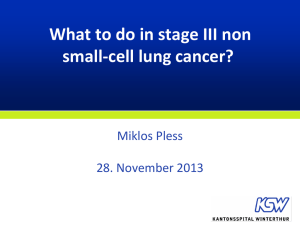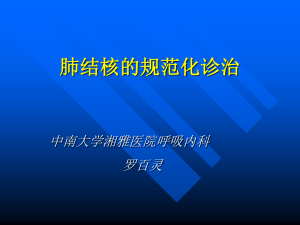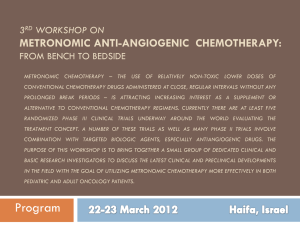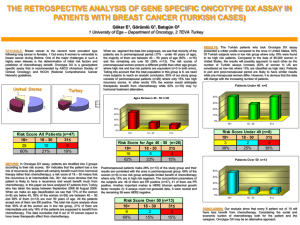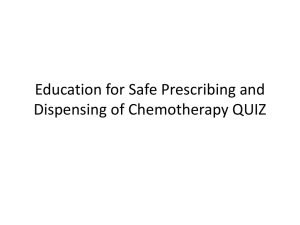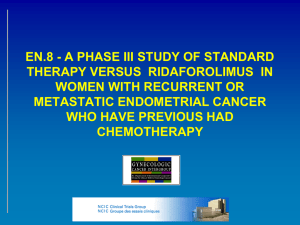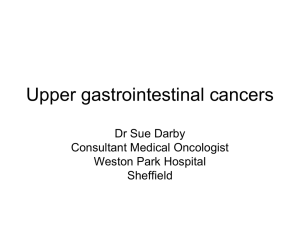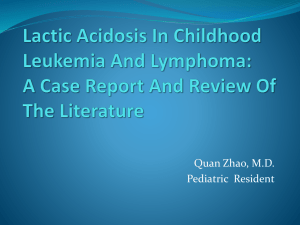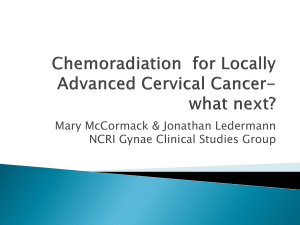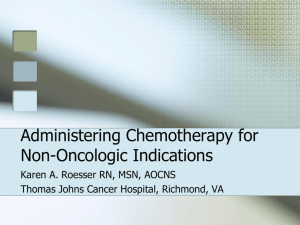Neo-adjuvant chemotherapy in Squamous cell carcinoma of head
advertisement
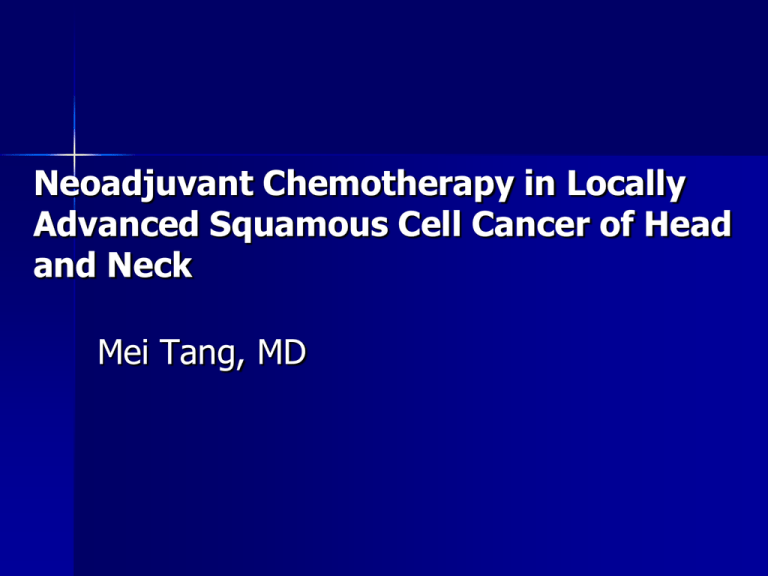
Neoadjuvant Chemotherapy in Locally Advanced Squamous Cell Cancer of Head and Neck Mei Tang, MD Head and Neck Cancer Worldwide New cases : 644,000 Cancer deaths: 350,000 About 5% of all cancers Local Recurrence: 40% - 60% Distant metastatic disease: 20 - 30% SCCHN The Role of Concomitant Chemotherapy in Locally Advanced SCCHN The Lancet March 18, 2000 MACH-NC 2000 63 trials (10,741 patients) 1965 – 1993 Cancers of oropharynx, oral cavity, larynx, and hypopharynx Many countries contributed to this report Overall Survival Benefit of Chemotherapy Timing of Chemotherapy Neoadjuvant/induction chemotherapy Concomitant chemotherapy (chemoradiotherapy, CRT) Adjuvant chemotherapy Timing of Chemotherapy Concomitant chemoradiotherapy is the current standard therapy for stage III and IV who do not undergo surgery Induction Chemotherapy: an attractive option To allow the assessment of tumor response To select appropriate patient for organ preservation To improves local control To reduce distant metastases Chemotherapy in Newly Diagnosed vs Recurrent Disease patients Response Rate Chemotherapy New Diagnosis Recurrence DDP/Bleo 71% 33% DDP/Bleo/Vinbl 74% 45% DDP/MTX/Bleo 88% 25% Bleo/MTX/VCR 71% 43% Evidence supporting induction chemotherapy 1. 2. 3. The VA trial No. 268 CT-RT vs Surg.-RT (P) The EORTC trials in early 1990s (PF) Intergroup trial 91-11(PF) A higher organ preservation or as good as concomitant CRT A lower rate of distant failure A trend toward improved survival, particularly in unresectable patients Adding Taxanes into induction regimen (TPF – RT) High complete response rate: 80-100% Local failure rate: 31% Distant failure rate: 6% Toxicity: Less nausea, mucositis, G-3 hearing loss, trombocytopenia and treatment related death. Higher neutropenic fever, Dosage in Chemoregimens TPF (q3wk) PF(q3wk) Docetaxol (T) 75 mg/m2 N/A Cisplatin (P) 75 mg/m2 100 mg/m2 5-FU (F) 1000 mg /m2 day 1-4 1000 mg/m2 day 1-5 Timing of Chemotherapy Limitations of the Data Trials between 1965-1993 Different chemotherapy regimens (drug/schedules) Platinum and 5-FU regimens are associate with 5% survival benefit at 5 years Response to chemotherapy was not taken into account 5-FU/Cisplatin in Previously Untreated Patients No. Patients Response (%) Complete Response (%) RTOG 84’ 23 91 39 Rooney 85’ 61 93 54 VALCSG 91’ 166 85 31 Paccagnella 94’ 118 80 31 Athanasiadis 97’ 71 83 32 Rationales of Induction Chemotherapy 1. There is increased responsiveness in previously untreated patients 2. Possible improvement in survival Improve locoregional control Decrease distant metastases 3. Surgical modification/organ preservation Patient Selection 1 Patient Selection 2 TPF Improves PFS and OS When It Was Compared to PF in Induction OS PFS TFP has better local control but no significant benefit in control of distant disease comparing to PF . Patient Selection Outside Clinical Trials Young (55 yo) PS 0-1 No majoy comorbilities (RI, uncontrolled DM, recent heart attached..) Large primary: T3 or T4 Extensive LN involvement (N2b or above) Good nutrition standard Targeted Therapy in SCCH-NC Cetuximab-RT vs. RT: PF vs. PF + Cetuximab It seems safe and effective: Carboplatin (AUC 2)/Taxol (135 mg/m2)/Cetuximab TPF/Cetuximab TPF-RT+cetuximab Targeted Therapy in SCCH-NC Everolimus: mTOR inhibitor Panitumumab + chemo Nimotumumab (EGFR ab) Is it time to change treatment paradigm? No direct comparison of induction chemotherapy to concomitant treatment using the newer regimen Induction chemotherapy has no defined role in definitive treatment strategies Summary Chemotherapy has established role in locally adv. SCCHN TPF – CRT is an alternative treatment options besides the standard concomitant chemoradiotherapy. CRT, not RT after TPF. Carboplatin TPF is better than PF in induction. It is possible but not proven that TPF-CRT is better than CRT with cisplatin. Dosage of Cisplatin in CRT 80% of pts tolerated > or = 6 doses of 30 mg/m2 weekly. Total: 180-210 mg 50% of pts tolerated 100 mg/m2 X 2. Total: 200 mg Weekly is flexibl. The goal is to continue XRT with delay or dose reduction. No G-3 or 4 renal toxicity in weekly SCCH-N in GBMC 2009 Total 238 cases of head neck cancer Eighty cases of cancers in oral cavity, oropharynx, larynx and hypopharynx Stage I: 22 Stage II: 9 Stage III: 14 Stage IV: 28 Unknown or Stage 0: 7

